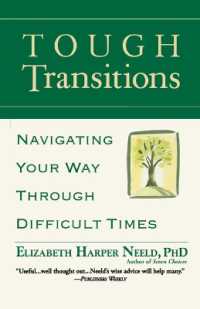- ホーム
- > 洋書
- > 英文書
- > History / World
Full Description
Pinning down Byzantium (or East Rome) is as difficult today as it was for contemporaries during its 1,000-year-long existence. Dimitri Obolensky sought to characterize its impact on Eastern Europe in his classic The Byzantine Commonwealth, focusing on the elements of religious doctrine, rites, and law which ruling elites there took from the emperor acting in tandem with the Constantinopolitan patriarchate. Chapters in this volume, Revisiting the Byzantine Commonwealth, address such basic questions as who the Byzantines thought they were and how they managed to maintain their hegemonial stance for so long. Other chapters reappraise the uses of Byzantium to elites and also to other sectors of societies from the Upper Adriatic to the Volga. Surveys are offered of three spheres which functioned independently of (and in one case, expressly in antithesis to) Byzantium, yet which overlapped and were constantly interacting with it--the Latin west, the Islamic-Christian east, and the world of the steppes. Candidates for 'Commonwealth membership' can be found within these spheres, too, along with transregional networks which functioned regardless of political borders. Aspects of Byzantium appealed to the variegated societies and cultures around it in very different ways, with the imperial elite taking keen interest in neighbouring peoples and making the most of Soft Power as material resources dwindled from the thirteenth century on. Some periods of outsiders' engagement with the empire were short-lived, but others proved long-lasting, underpinned by ecclesiastical institutions and monastic networks. The volume aims to foster a more rounded approach to the phenomenon of Byzantium, and a better understanding of how and why it impinges on so many Eurasian cultures and polities to this day.
Contents
1: The Byzantine Phenomenon
Part I. WHO DO THEY THINK THEY ARE?
2: Byzantine Globalism: The Power of Attraction
3: Commonwealth, Empire, or Nation-State?
4: What Did It Mean to Be 'Roman' in Byzantium?
5: Commonwealth of Elect Nations: A Contradiction in Terms?
6: Identity through Language in the Byzantine Commonwealth
7: Keeping Up Appearances: Byzantine Perspectives of 'Legality' and the Italians
Part II. HOW DO THEY DO IT?
8: Laying Down the Law in Byzantium: Law-Making and Adjudication
9: Identity, Law, and Beards: Judicial Shaving in Byzantium, c.600-900
10: A Taktikal Retreat?: Middle Byzantine Provincial Administration Revisited
11: Byzantium's Empires of Gold
12: The Patriarchate of Constantinople and Its Register: Documents, Agents, and Interconnectivity
13: The Byzantine Visual Commonwealth
BORDERLINE CASES
14: Attracting Elites from the Empire's Periphery
15: Byzantine 'Zomia'?: Spaces of Refusal between Centre and Periphery, 500-1200
16: 'As Though from India Itself': Stories of Byzantium
17: Byzantino-Turkish Diplomacy and the Loss of Western Asia Minor, 1260-1335
18: Agents of Commercial and Diplomatic Exchange: Amalfitans in Byzantium in the Tenth to Twelfth Centuries
19: Imagining Byzantium in Norse Romance
The Latin West
20: Frankish Commonwealth or Imperium Romanum?: The Empire in the West, 750-1500
21: Parallel Spheres: Monasticism East and West c.1000-1500
22: Alignment, Entanglement, and Antagonism: Byzantium and the West
23: The Byzantinization of the Roman Church under Innocent II (1130-1143)
24: Byzantium and the Crusades
PART V. THE ISLAMIC-CHRISTIAN EAST AND BEYOND
25: Byzantium, Rum, and the bilad al-Islam
26: Looking East: Early Christian Art beyond Christian Hegemony
27: Melkite Translations of Byzantine Law-Books into Arabic
28: Art and Eschatological Empire between the Islamic East, Byzantium, and Latin Christendom: Sultan Baybars I's Mausoleum in Damascus
29: Romans, Egyptians, and the Second Arab Siege of Constantinople (717/18)
30: The Byzantine Commonwealth: A View from the East
Part VIA. Obolensky's Commonwealth
31: Reclaiming the Balkans: A Study in Byzantine Soft Power
32: Bulgaria-Prime Candidate for Byzantine Commonwealth Membership?
33: A Virtual Empire?: Byzantium and the Eastern Adriatic Coast
34: Before Byzance après Byzance: The Making of Wallachia and the Byzantine Political Toolkit
35: Languages of Art
36: Finding the Frontiers of the Commonwealth
Part VIb. Obolensky's Commonwealth
37: On Rus and the Commonwealth: Old Questions in the Light of Some New Studies
38: Early Rus Political Culture versus Byzantine Law: Reconciling Two Contradictory Ideologies
39: The Reluctant Empire
40: Byzantine Literature in the Slav World: Serendipity or Intention?
41: Non-elite Church Contacts between Byzantium and Rus in the Palaiologan Period
Part VII. Steppe Changes
42: The Typology of the Nomad State in Western Eurasia
43: From War to Peace in Medieval Steppe Empires
44: Boundaries and Bonds: Khazaria and the Commonwealth
45: Bargaining with Byzantium: The North Caucasian Kingdom of Alania and the Empire
46: Triangles into Spheres: Trade, Faith, and the Palaiologan Balancing Act after 1261
47: Epilogue








